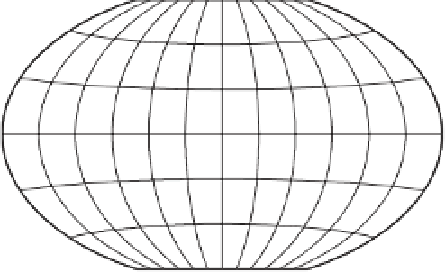Geoscience Reference
In-Depth Information
observations of the X-discontinuity and found
that it was mainly observed in regions of active
or ancient subduction beneath continental crust,
and thought that it would be caused by the tran-
sition from coesite to stishovite (Akaogi
et al
.,
1995). However, this phase transition would
require free silica to exist in the mantle, which is
highly unlikely. Alternatively, Matsukage
et al
.
(2005) propose that the X-discontinuity might be
due to a phase transition in pyroxene from the
orthorhombic to high-pressure monoclinic phase.
Examples of seismic observations are shown in
Canada (Figure 10.5b) and in Asia (Figure 10.5c)
where the X-discontinuity is seen both in the
PP precursors and the Pds receiver functions.
Reflections from the X-discontinuity appear
much more scattered than refections from the
Lehmann discontinuity (Deuss & Woodhouse,
2004), so it has not been possible to determine
Clapeyron slopes for the X-discontinuity and find
out if the discontinuity indeed has a positive
Clapeyron slope, as would be the case for the
coesite to stishovite phase transition.
been found in many different studies and at a
range of depths. Figure 10.9a shows that reflec-
tions from around 800-900 km depth are found
in several different regions including continents
and oceans (Kawakatsu & Niu, 1994; Niu &
Kawakatsu, 1997; Vinnik
et al
., 2001; Deuss &
Woodhouse, 2002). These reflectors also show
up in the SS and PP precursor and Pds receiver
function histograms (Figure 10.4). There are also
suggestions of deeper lower mantle reflectors
from 1000-1200 km depth (Figure 10.9b), in par-
ticular in the Indonesian subduction zone where
many different studies have found observations of
lower mantle reflectors (Niu & Kawakatsu, 1997;
Vinnik
et al
., 2001; Deuss & Woodhouse, 2002).
Reflections from 1000-1200 km depth are limited
to subduction zone regions. Deeper reflectors up
to 1800 km depth have also been seen (Vinnik
et al
., 2001; Kaneshima & Helffrich, 2009). These
deep reflectors may also be related to the top
or bottom of the subducted slab. Lower man-
tle reflectors have also been observed at 785,
940 and 1200 km depths using P
P
precursors
(LeStunff
et al
., 1995; Whitcomb & Anderson,
1970). However, other phases are easily mistaken
for lower mantle reflectors in this data type (Xu
et al
., 1998), so these observations will be disre-
garded here.
10.5 Lower Mantle
Lower mantle reflectors (or scatterers, as we are
not sure these are actually discontinuities) have
800-900 km discontinuity
1000-1200 km discontinuity
880
1200
780
900
1200
8
10
8
30
1
2
30
81
0
82
0
87
0
1070
1
1
70
900
10
50
1
2
00
860
9
20
915
9
8
0
1
08
0
(a)
(b)
Fig. 10.9
Maps showing locations where the lower mantle reflectors have been observed using a range of data types
for (a) 800-900 km (Johnson, 1969; Muirhead & Hales, 1980; Souriau, 1986; Revenaugh & Jordan, 1991a; Revenaugh
& Sipkin, 1994; Petersen
et al
., 1993; Kawakatsu & Niu, 1994; Niu & Kawakatsu, 1997; Vinnik
et al
., 1998, 2001;
Liu
et al
., 2003; Deuss, 2009) and (b) 1000-1200 km depth (Johnson, 1969; Muirhead & Hales, 1980; Niu &
Kawakatsu, 1997; Vinnik
et al
., 1998, 2001; Deuss & Woodhouse, 2002).







































































































































































































































































































































































































































































































































































































































